The world is full of blue-feathered birds. However, all those beautiful blues seen in bird feathers are not biological pigments, but rather structural colors that are purely a trick of optics. Similar to how the sky and ocean can also look blue to us, these birds’ feathers refract light in just the right way to appear blue to our eyes. In fact, blue feather pigments simply don’t exist in the bird world, so every “blue” bird you see uses this same trick of structural color to fool your eyes! You can test this for yourself by backlighting a single blue feather, which breaks up the light magic and reveals the feather’s true pigments, gray to black melanins:
Although there are hundreds and hundreds of bird species with at least some of these amazing structural blue feathers, there are far fewer in which one or both sexes appear blue all over from head to tail. While some of the birds on this list may have a tiny bit of black, gray, and/or white feathers in the mix, they still have a predominantly blue appearance that sets them apart from other mostly blue birds with more distinct patches of non-blue feathers. See images of some of the bluest blue jewels of the bird world below, then check out the full list at the end!
(Note: black birds with just a bluish iridescence are not included on this list. However, iridescence is a form of structural color as well!)
Azure-Shouldered Tanager Thraupis cyanoptera

The azure-shouldered tanager gets its name from the small but bright azure-blue spot on its upper wing.
The Azure-shouldered tanager is native to the Atlantic Forest region of southeastern Brazil. Both the male and female are a beautiful mix of turquoise and powdery blue hues.
Blackish-Blue Seedeater Amaurospiza moesta

Like many of the birds on this list, only the male blackish-blue seedeater has blue plumage, while the female is brown.
The blackish-blue seedeater is native to the Atlantic Forest region in South America. The male’s feathers are a dark slate-blue.
Blue Bunting Cyanocompsa parellina

The male blue bunting has brighter blue patches on its head, cheek, shoulder, and rump.
©drferry/Shutterstock.com
The blue bunting is native to woodlands and thickets of Mexico and Central America. The male’s plumage is a mix of sky-blue, deep blue, blackish-blue, and ultramarine feathers.
Blue Coua Coua caerulea

Even the blue coua’s bare skin around the eyes is blue!
The blue coua is endemic to Madagascar. Both the male and female are a lovely dark blue hue with a violet sheen on the wings and tail.
Blue Finch Rhopospina caerulescens

The blue finch’s rich blue plumage contrasts nicely with its bright yellow beak.
The blue finch is native to open savanna, grassland, and cerrado in parts of Brazil and Bolivia. The male’s plumage is a deep cobalt-blue to indigo-blue.
Blue-Gray Tanager Thraupis episcopus

In Trinidad and Tobago, the blue-gray-tanager is nicknamed “blue jean.”
©Artush/Shutterstock.com
The blue-gray tanager is distributed across Mexico, Central America, northern South America, and Trinidad and Tobago. Both the male and female are a mix of gray-blue, powder-blue, and sky-blue feathers, although the female is slightly duller.
Blue Rock-Thrush Monticola solitarius

The blue rock thrush is the official national bird of Malta.
©non15/Shutterstock.com
The blue rock-thrush is widely distributed across areas of North Africa and southern Eurasia. The male’s feathers are a deep blue with spangling.
Blue Whistling-Thrush Myophonus caeruleus

Depending on the subspecies, blue whistling-thrushes have either black or yellow bills.
©Panu Ruangjan/Shutterstock.com
The blue whistling-thrush is native to forests across portions of Central Asia, South Asia, Southeast Asia, and China. China. Both the male and female have blackish-blue to deep blue plumage with metallic violet-blue and silvery spots, although the female is duller.
Deep-Blue Flowerpiercer Diglossa glauca

The deep-blue flowerpiercer is also known as the golden-eyed flowerpiercer.
©Ondrej Prosicky/Shutterstock.com
The deep-blue flowerpiercer is native to the eastern slope of the Andes Mountains in South America. Both the male and female have blue plumage, but the male is a deeper blue with the female a duller blue.
Dull-Blue Flycatcher Eumyias sordidus
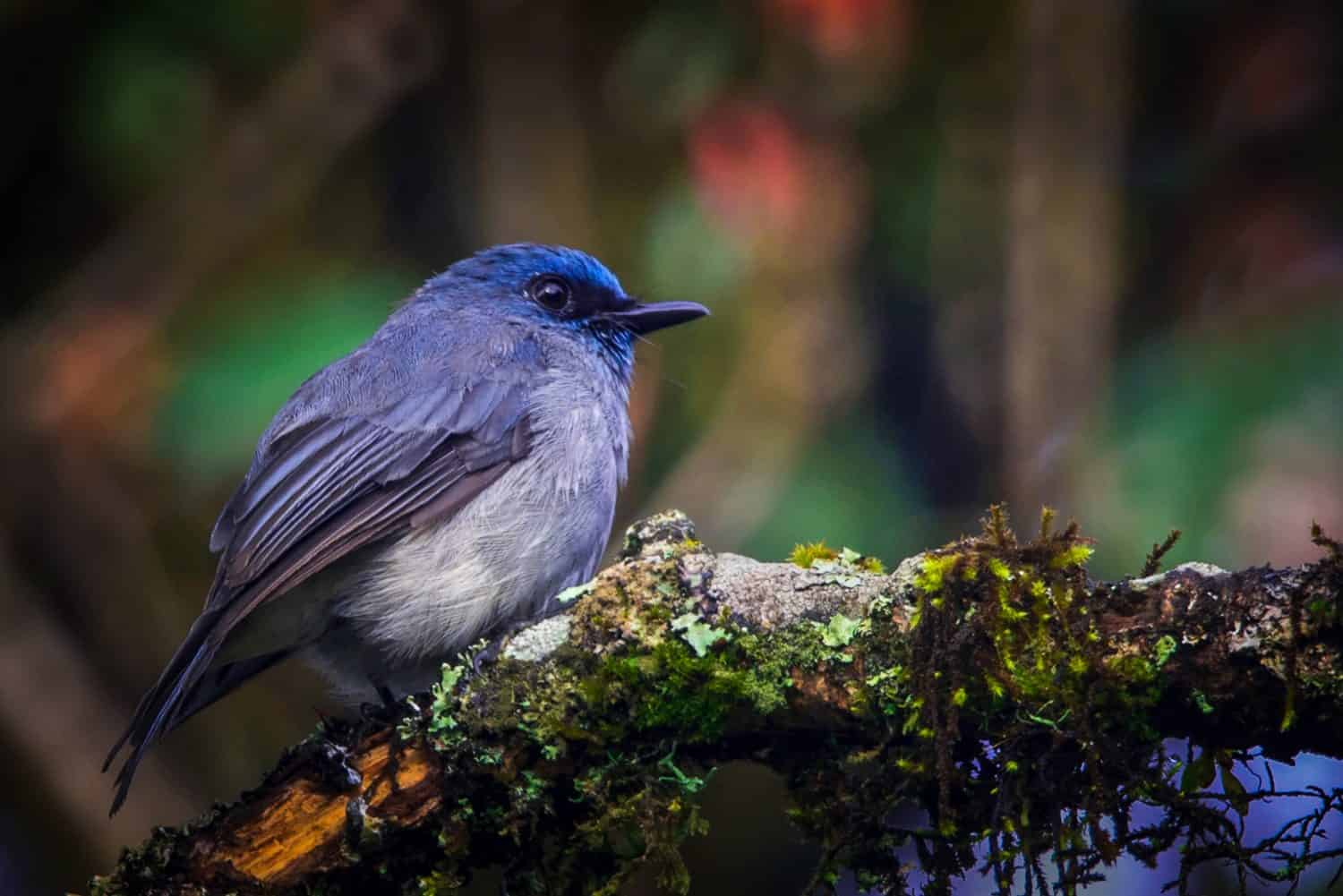
The dull-blue flycatcher is one of several species on this list where both males and females are blue, but the males are brighter overall.
©Kumara Senanayake/Shutterstock.com
The dull-blue Flycatcher is endemic to Sri Lanka. Both the male and female have gray-blue to pale blue plumage with brighter blue highlights, although the female is slightly duller.
Himalayan Shortwing Brachypteryx cruralis
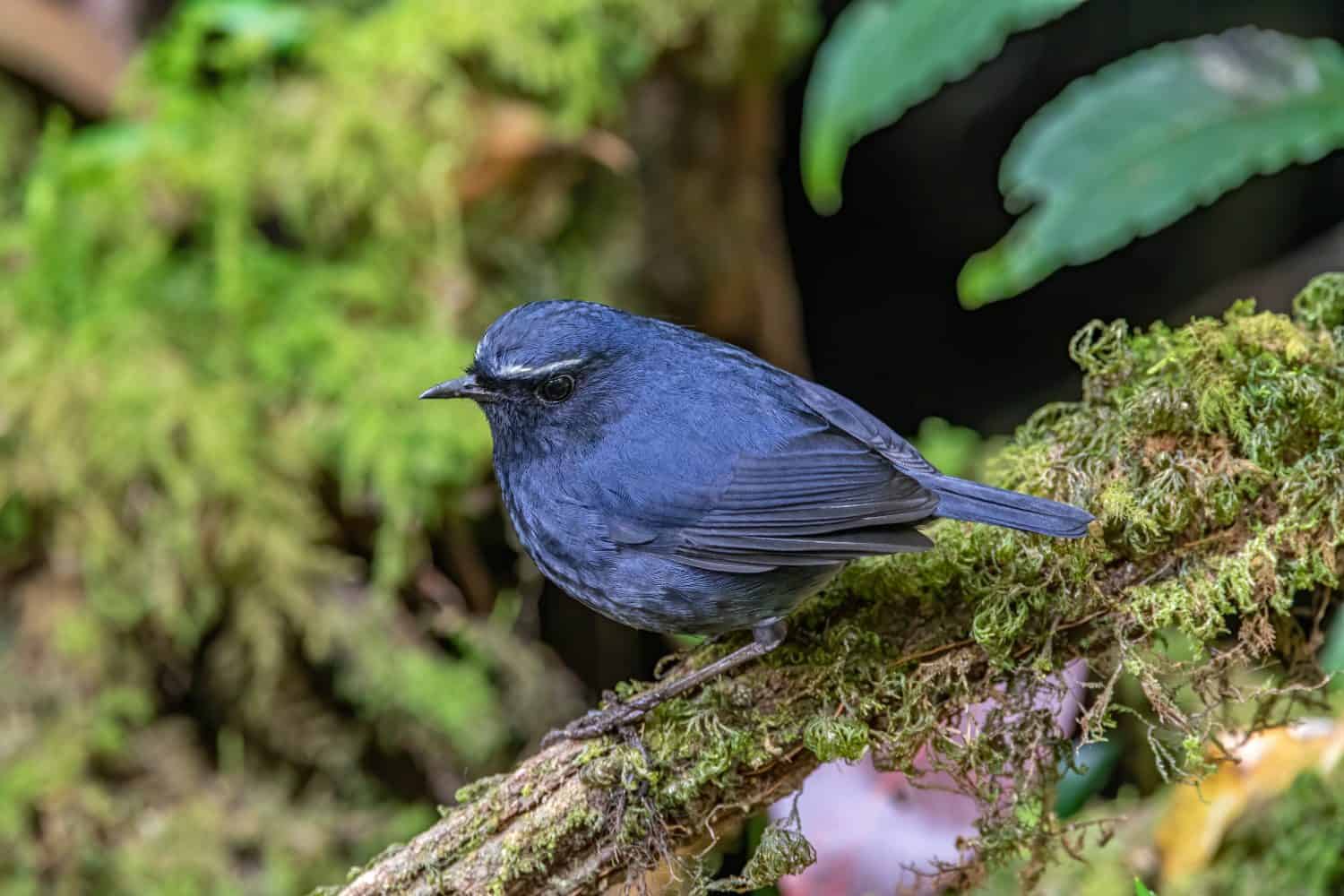
The male
Himalayan
shortwing also has a thin white eyebrow.
©luck luckyfarm/Shutterstock.com
The Himalayan shortwing is native to montane forests of Southeast Asia. The male’s plumage is a satiny dark blue.
Hyacinth Macaw Anodorhynchus hyacinthinus
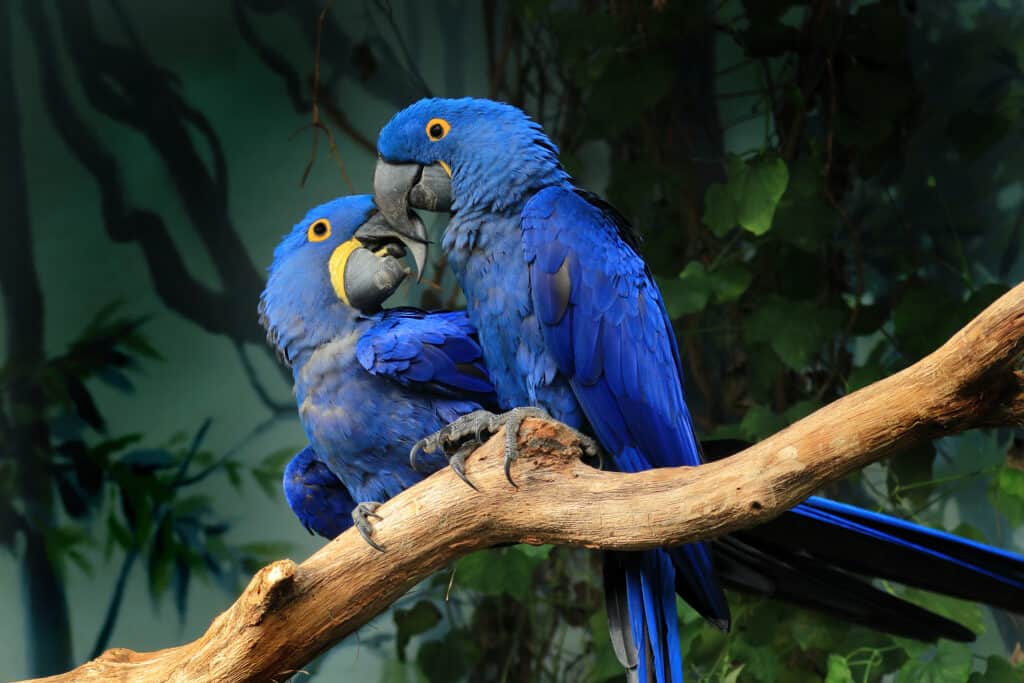
The hyacinth macaw is the largest macaw species and one of the largest parrots overall.
©Vaclav Matous/Shutterstock.com
The hyacinth macaw is native to parts of Brazil, Bolivia, and Paraguay in South America. Both the male and female have the same cobalt-blue tinged with violet-blue plumage. (Those bits of yellow around the eye and beak are not feathers, but rather bare skin, so they still got on this list.)
Indigo Bunting Passerina cyanea
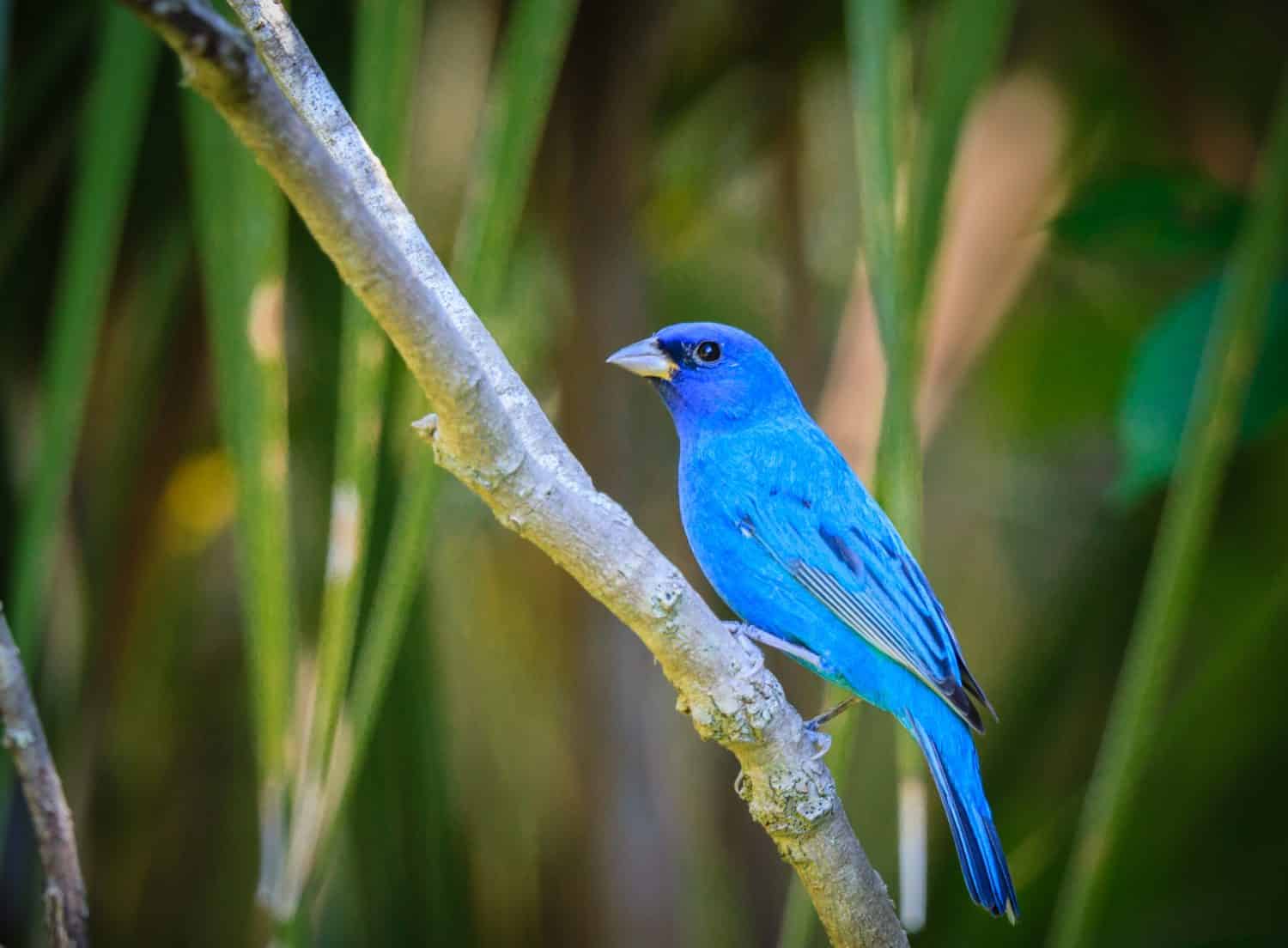
This male indigo bunting’s brilliant blue plumage is only for the breeding season; its off-season plumage is a duller patchwork of blue and brown.
©jo Crebbin/Shutterstock.com
The indigo bunting is a migratory species that can be found in North America, Central America, and the Caribbean. The male’s breeding season plumage is a vibrant blue with a purplish-blue head.
Indigo Macaw Anodorhynchus leari

The indigo macaw is also known as Lear’s macaw, named for English author and artist Edward Lear (1812-1888).
©buteo/Shutterstock.com
The indigo macaw is an endangered species endemic to a small region in the interior of northeastern Brazil. Both the male and female have the same all-over metallic blue plumage, with small patches of yellow skin around the eye and beak similar to its close relative, the hyacinth macaw.
Javan Whistling-Thrush Myophonus glaucinus
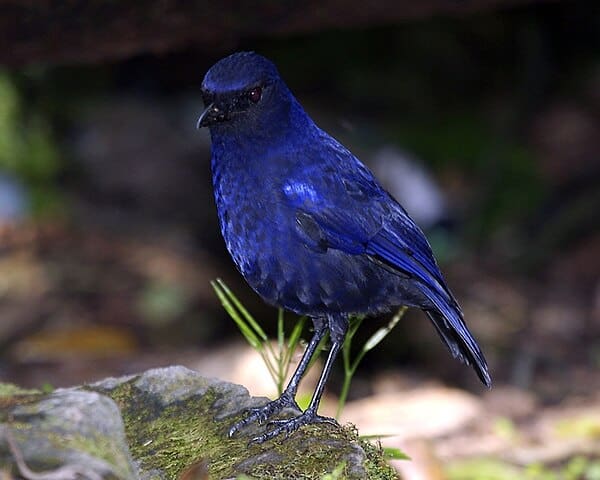
This Javan whistling-thrush is a stunning sapphire color.
©Lip Kee from Singapore, Republic of Singapore / CC BY-SA 2.0 – Original / License
The Javan whistling-thrush is a flycatcher native to montane forests of Java and Bali. Both the male and female are a deep, dark blue, although the female is duller and slightly browner.
Large Niltava Niltava grandis
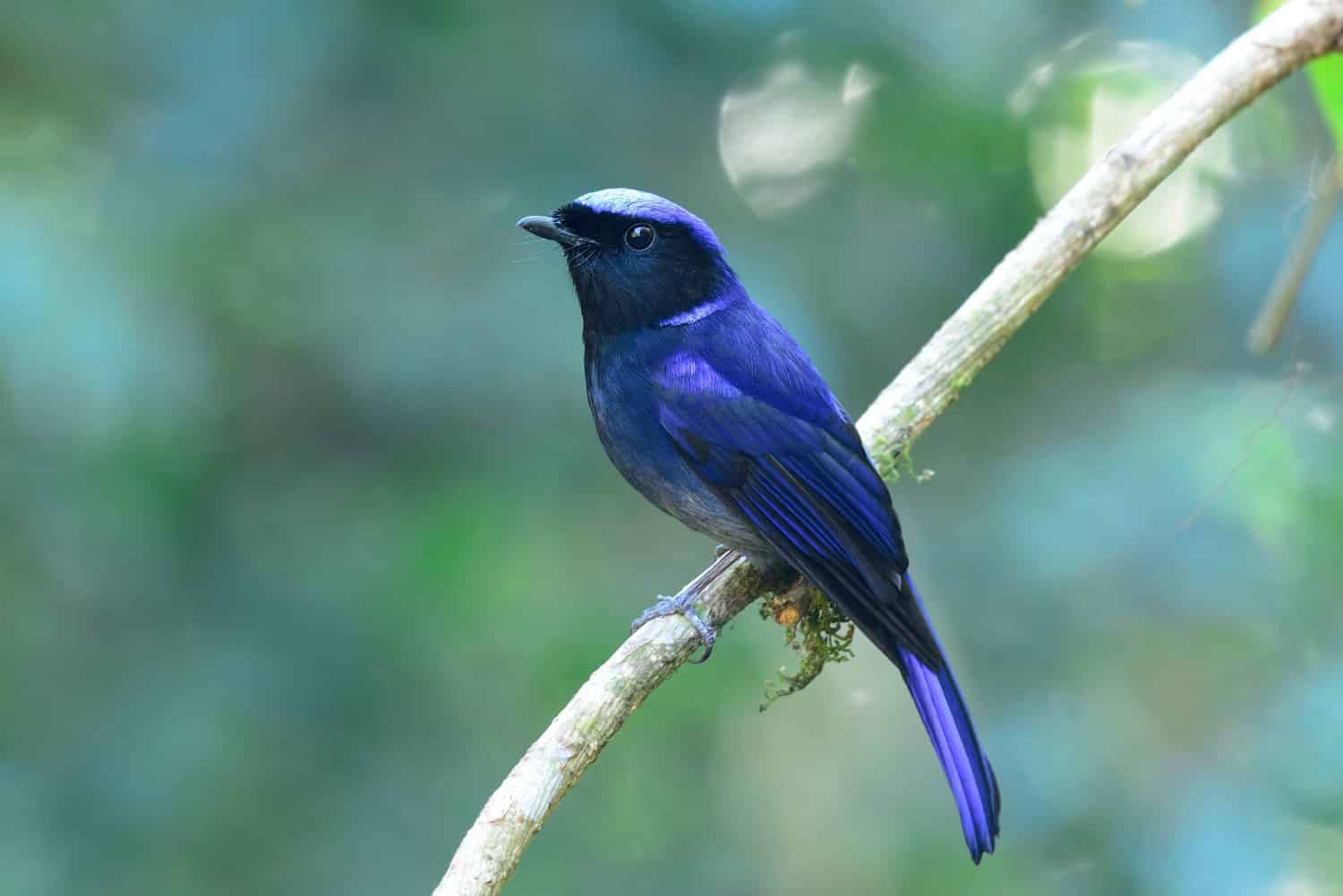
The large niltava is the largest of the Asian flycatcher species.
©Anusak Thuwangkawat/Shutterstock.com
The large niltava is native to broadleaf forests in areas of South and Southeast Asia. The male’s plumage is a mix of deep ultramarine, dark blue, and black-blue feathers.
Mountain Bluebird Sialia currucoides
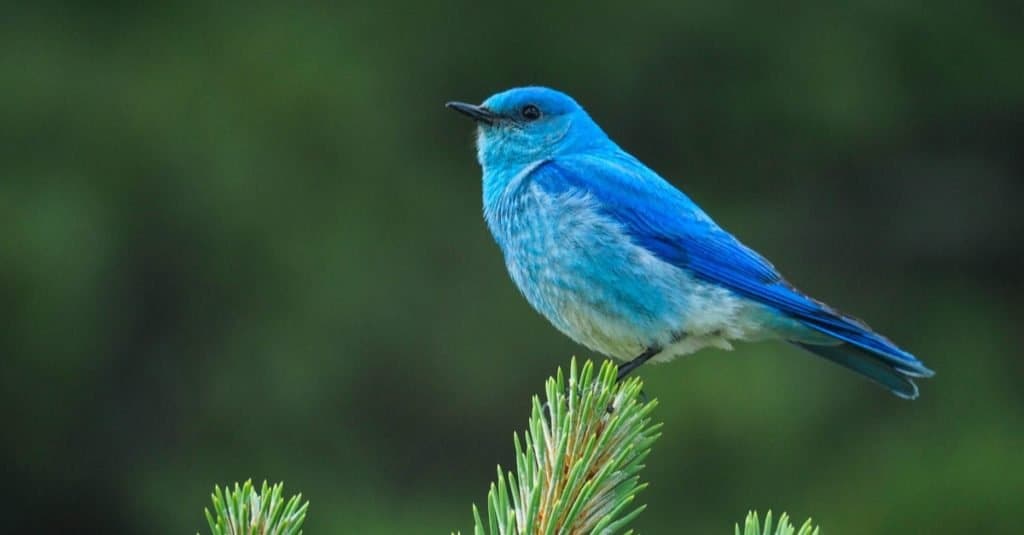
The mountain bluebird is the official state bird of both Idaho and Nevada.
©MTKhaled mahmud/Shutterstock.com
The mountain bluebird is native to mountainous regions of Western North America The male is bright cerulean to turquoise above, fading to paler blue into whitish-blue below, without any of the orange coloration that other bluebird species have.
Nilgiri Flycatcher Eumyias albicaudatus
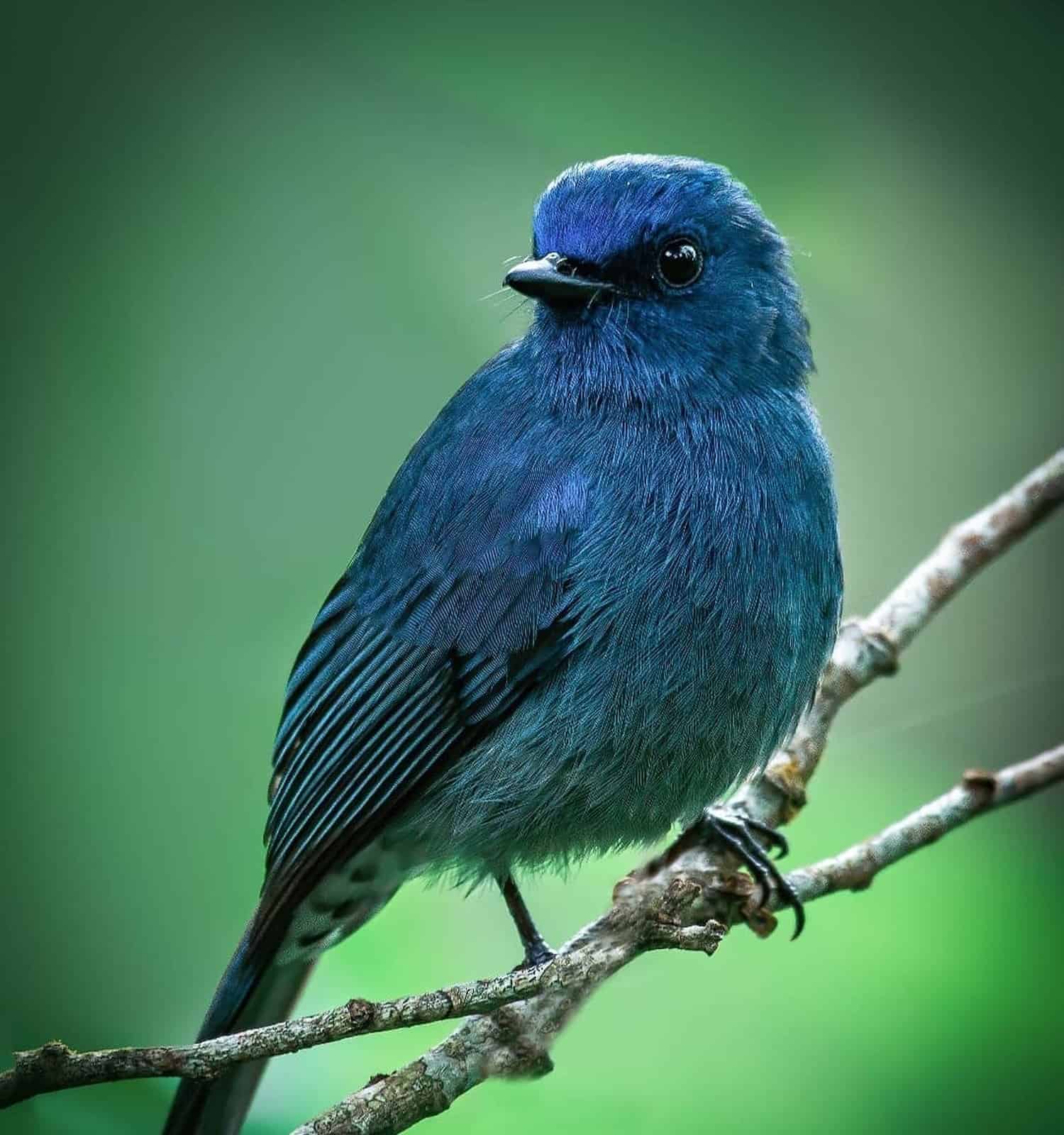
The Nilgiri flycatcher is named for India’s Nilgiri Mountains in the Western Ghats.
©Featured photography/Shutterstock.com
The Nilgiri flycatcher is endemic to southwestern India. The male is an all-over deep indigo-blue.
Pale Blue Flycatcher Cyornis unicolor

The pale blue flycatcher also has a bright blue eyering.
©Jamil Bin Mat Isa/Shutterstock.com
The pale blue flycatcher is native to forests of Southeast Asia. The male has cobalt blue plumage.
Pinyon Jay Gymnorhinus cyanocephalus
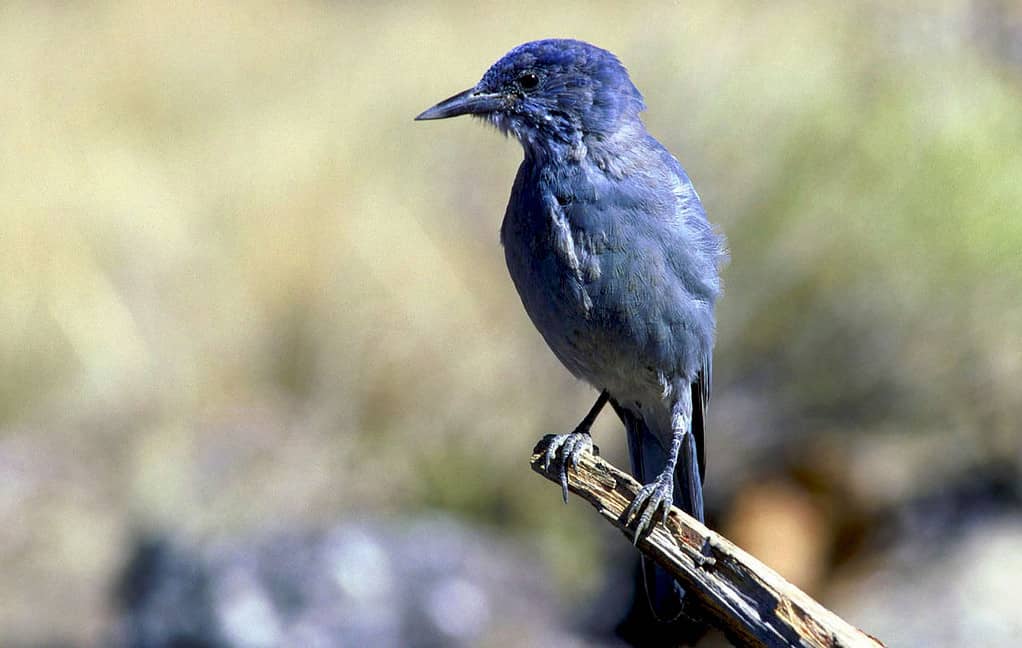
Although many of the pinyon jay’s jay cousins also have lots of blue feathers, only one other species is uniformly blue enough to appear on this list.
The pinyon jay is found in Western North America, where they nest primarily in pinyon-juniper woodlands. Both the male and female are dull grayish-blue with deeper blue on the head, although this head color is a bit duller in the female.
Royal Sunangel Heliangelus regalis
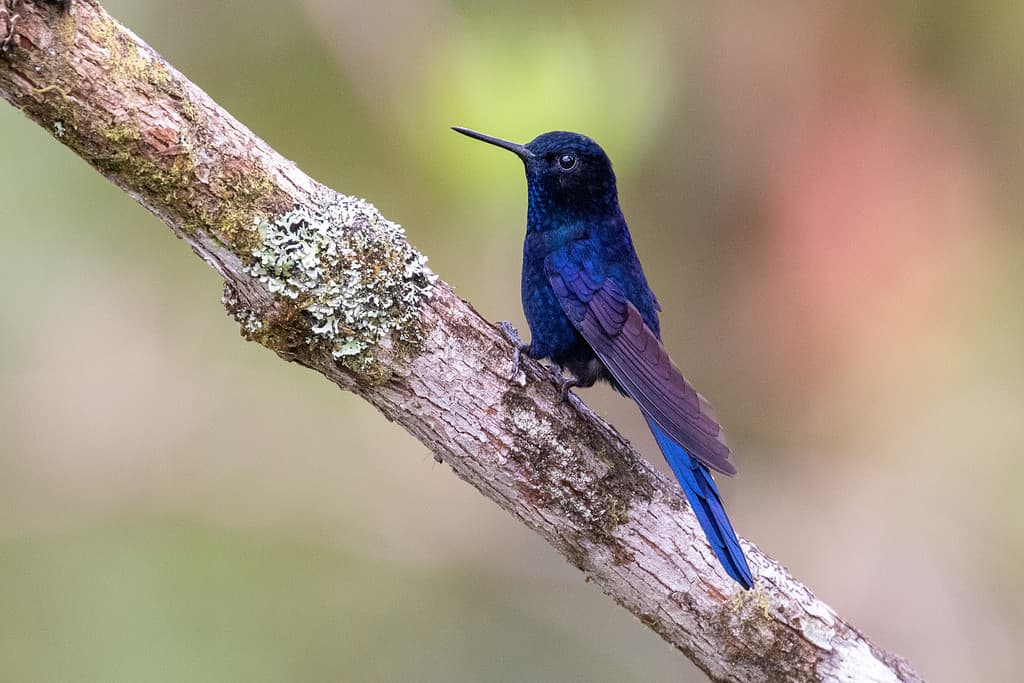
There are two subspecies of royal sunangel recognized.
The royal sunangelEcuadorive to Ecuador and Peru. It is the only hummingbird species with males that are almost entirely blue. Their plumage is primarily deep metallic blue, with areas of indigo to violet and iridescence that vary by subspecies.
Satin Bowerbird Ptilonorhynchus violaceus

The male satin bowerbird is not only blue but also likes to collect blue things to decorate its bower and impress potential female mates!
©Imogen Warren/ via Getty Images
The satin bowerbird is endemic to forests of eastern Australia. The male has an all-over deep, shiny, indigo-blue sheen.
Small Niltava Niltava macgrigoriae
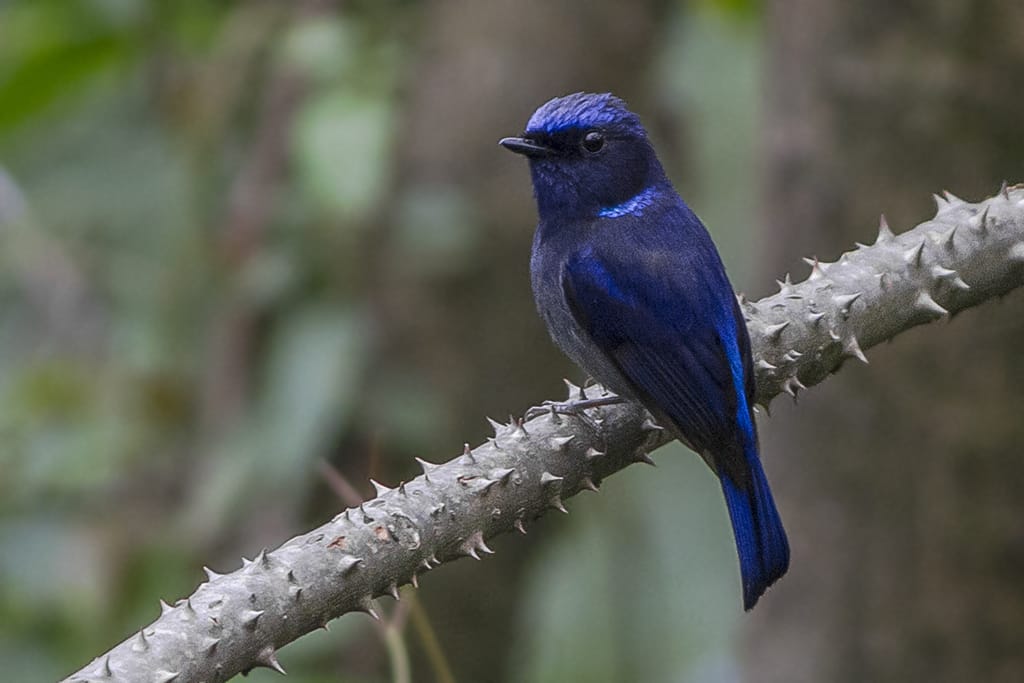
The small niltava has shiny blue forehead and neck patches.
The small niltava is native to the Indian Subcontinent and Southeast Asia. The male is a beautiful deep sapphire blue with some bright blue and purplish-blue highlights and paler blue underparts.
Spix’s Macaw Cyanopsitta spixii

Spix’s macaw is also known as the little blue macaw.
©Danny Ye/Shutterstock.com
The Spix’s macaw is endemic to Brazil, although it is currently believed extinct in the wild. However, a small population exists in captivity, and there are plans to one day re-establish a wild population. Both the male and female have the same plumage, including a pale bluish-gray head and grayish-blue to violet-blue body.
Taiwan Whistling-Thrush Myophonus insularis
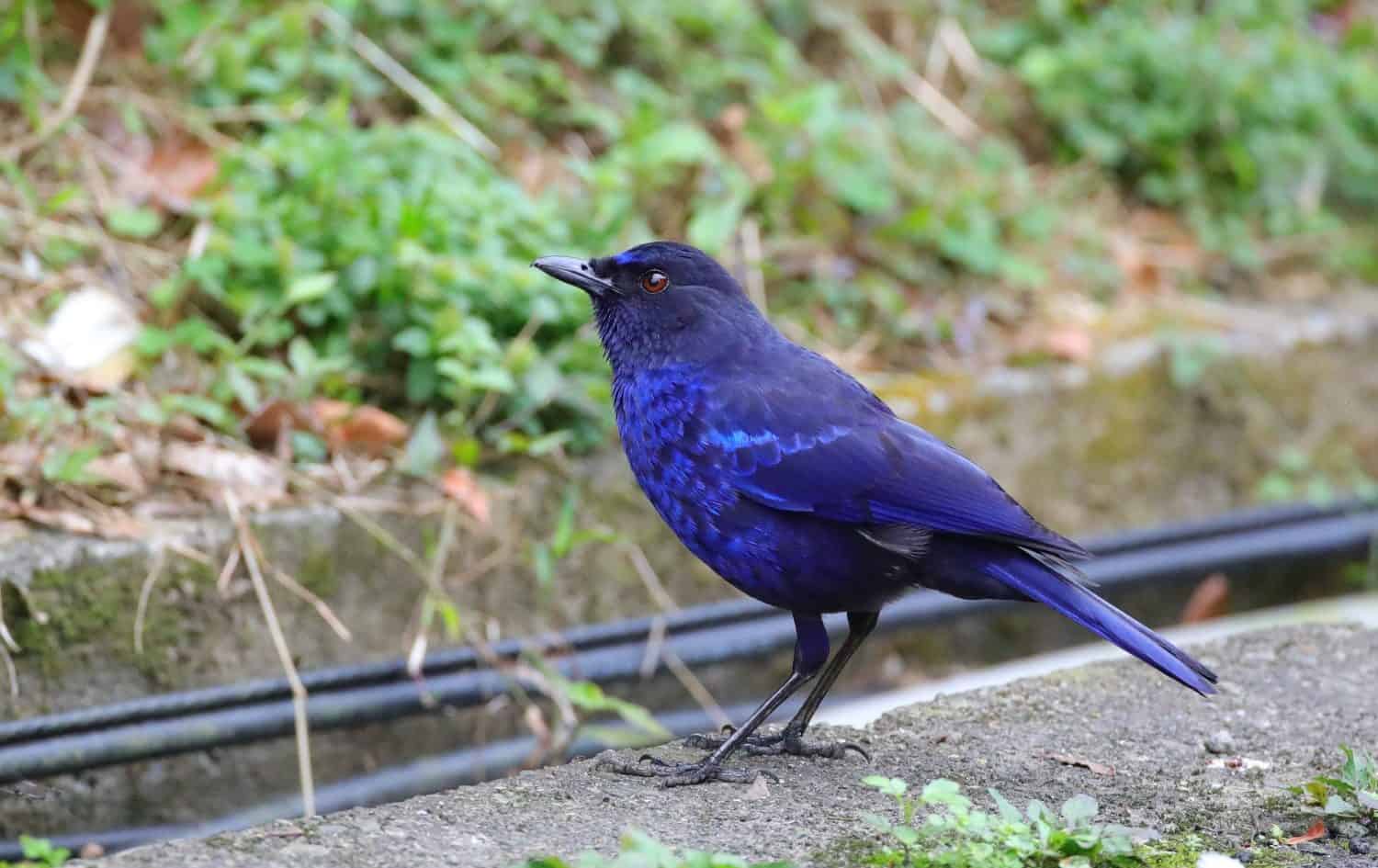
The Taiwan whistling-thrush is also known as the Formosan whistling thrush.
©brucelin/Shutterstock.com
The Taiwan whistling-thrush is endemic to Taiwan. Both the male and female have deep dark blue to blackish-blue plumage highlighted with royal blue spangling.
Tenerife Blue Chaffinch Fringilla teydea
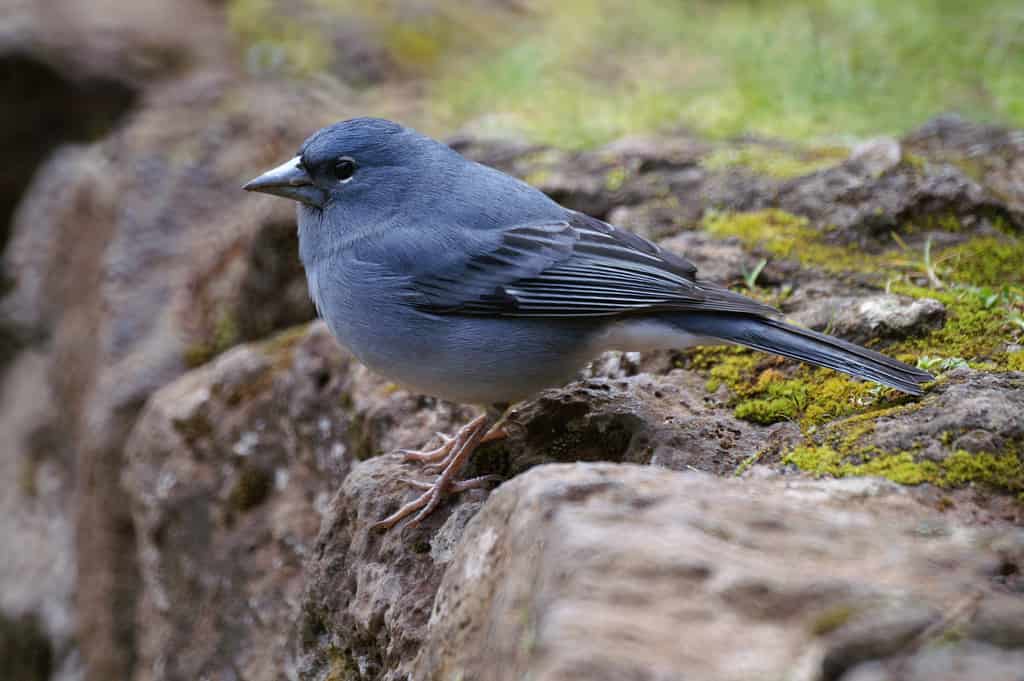
The Tenerife blue chaffinch also has a steel-blue beak.
The Tenerife blue chaffinch is endemic to the Canary Islands. The male is a deep slate-blue to grayish-blue.
Tit-Like Dacnis Xenodacnis parina
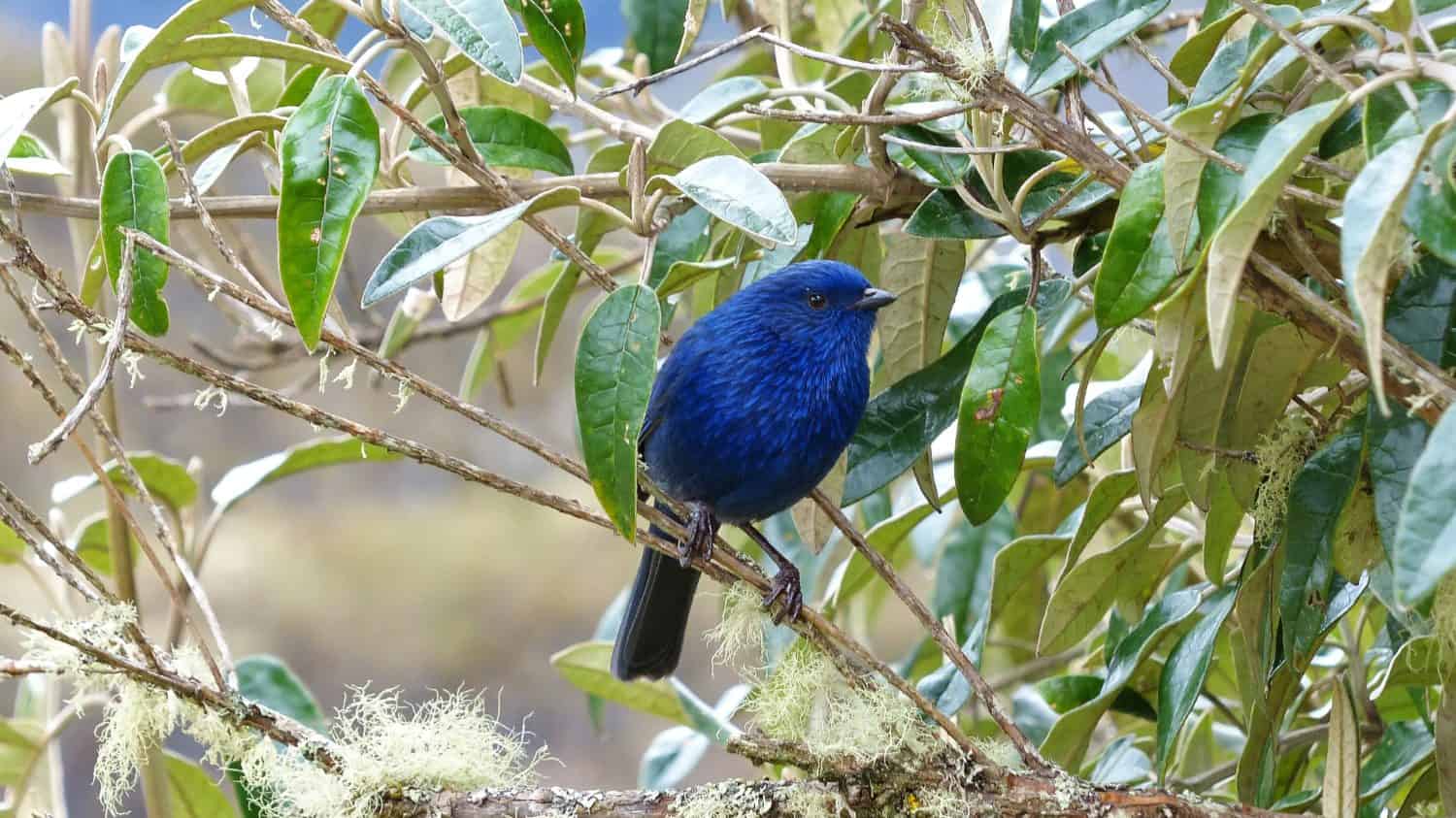
The tit-like dacnis has a dark gray to black bill, legs, and feet.
©ireneuke/Shutterstock.com
The tit-like dacnis is native to the Andes region of Ecuador and Peru. The male’s plumage is deep blue.
Turquoise Flycatcher Eumyias panayensis
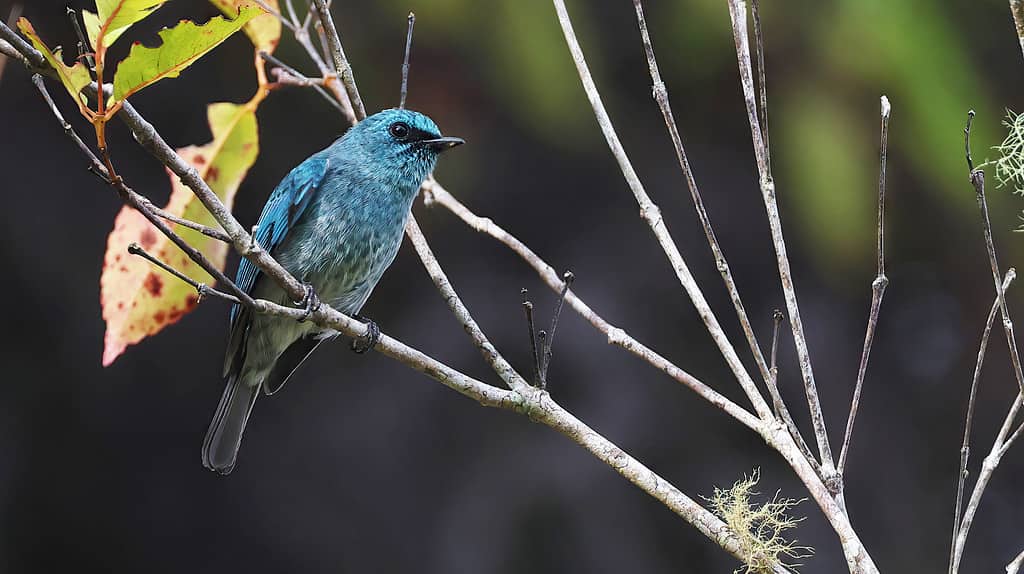
There are seven subspecies of turquoise flycatchers, each with slight variations in plumage.
©Manakin/ via Getty Images
The turquoise flycatcher is native to Indonesia and the Philippines. Both the male and female are predominantly turquoise, although the female is a bit duller.
Ultramarine Grosbeak Cyanoloxia brissonii

The male ultramarine grosbeak has bright blue forehead, eyebrow, cheek, and shoulder patches.
©Geraldo Morais/Shutterstock.com
The ultramarine grosbeak is found in two disjunct populations in South America. The male is a dark ultramarine with bright blue highlights on its head.
Unicolored Jay Aphelocoma unicolor
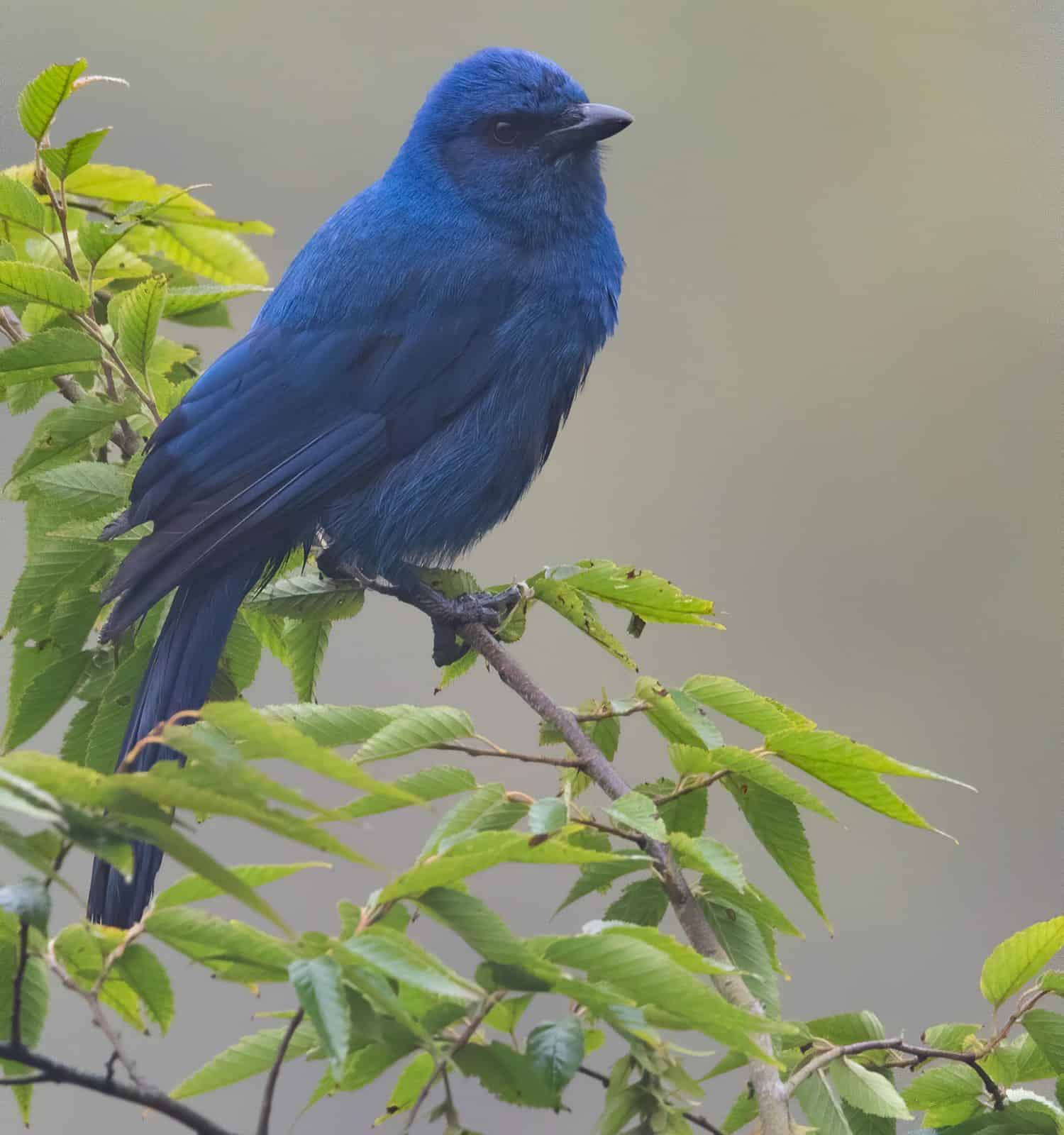
Although many jays have blue plumage, only the pinyon jay and unicolored jay are an all-over blue.
©Agami Photo Agency/Shutterstock.com
The unicolored jay is native to evergreen forests in Mexico and Central America. Both the male and female have the same rich indigo-blue color.
Verditer Flycatcher Eumyias thalassinus
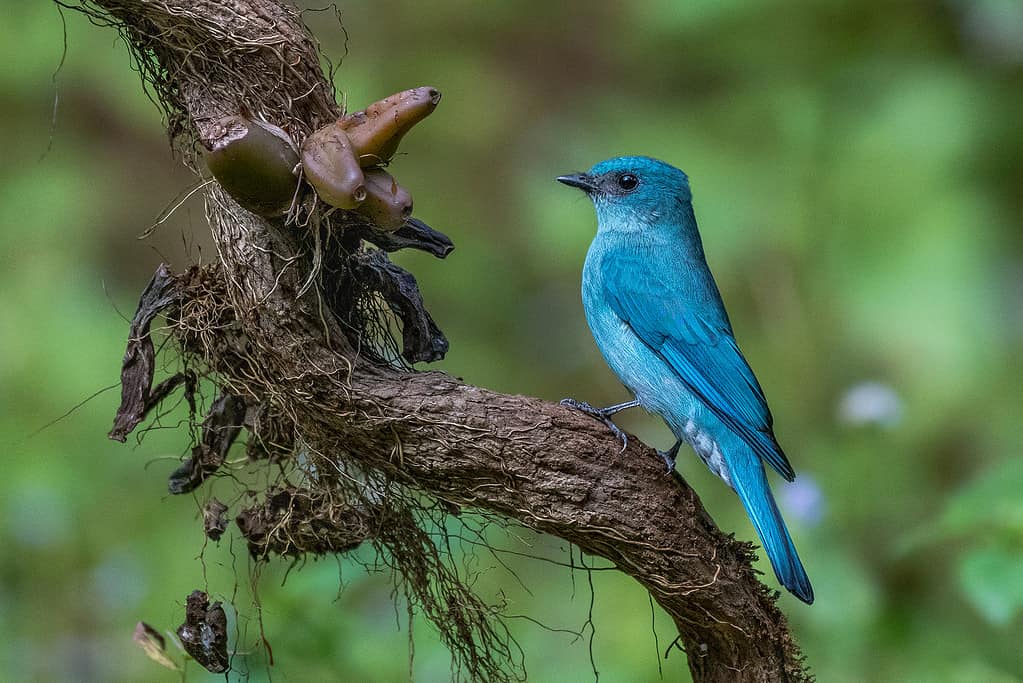
The verditer flycatcher gets its name from verditer blue, a synthetically produced azurite pigment.
The verditer flycatcher is native to South and Southeast Asia. Both the male and female are a verditer-blue, although the female is a little duller and greyer.
White-tailed Robin Myiomela leucura

As its name suggests, the white-tailed robin does have a tiny bit of white on its tail, but it’s still blue enough for this list!
©PanuRuangjan/ via Getty Images
The white-tailed robin is native to forests in areas of South and Southeast Asia. The male is dark black-blue with a shiny blue forehead and shoulder patches.
The Full List of 61 Blue Birds
| Species | Where Found | Blue Plumage Description |
|---|---|---|
| 1. Amazonian Grosbeak Cyanoloxia rothschildii | N South America | male is dark blue with bright blue highlights on head |
| 2. Azure Roller Eurystomus azureus | North Maluku | both sexes are dark glossy ink-blue |
| 3. Azure-Shouldered Tanager Thraupis cyanoptera | Brazil | both sexes are a mix of turquoise and powdery blue |
| 4. Blackish-Blue Seedeater Amaurospiza moesta | Argentina, Brazil, Paraguay | male is dark slate-blue |
| 5. Blue-Black Grosbeak Cyanoloxia cyanoides | S Mexico, Central America, N South America | male is dark blackish-blue with brighter blue highlights on head |
| 6. Blue Bunting Cyanocompsa parellina | Mexico & Central America | male is a mix of sky-blue, deep blue, blackish-blue, and ultramarine |
| 7. Blue Coua Coua caerulea | Madagascar | both sexes are dark blue with violet sheen on wings and tail |
| 8. Blue Cuckooshrike Cyanograucalus azureus | West & Central Africa | male is brilliant glossy blue; female duller and greener blue |
| 9. Blue Finch Rhopospina caerulescens | Brazil and Bolivia | male is deep cobalt-blue to indigo-blue |
| 10. Blue-Fronted Robin Cinclidium frontale | S & SE Asia | male is deep indigo-blue with shiny blue forehead and shoulder |
| 11. Blue-Gray Tanager Thraupis episcopus | Mexico, Central America, N South America, Trinidad and Tobago | male is a mix of gray-blue, powder-blue, and sky-blue; female slightly duller |
| 12. Blue Mockingbird Melanotis caerulescens | Mexico | both sexes are deep blue |
| 13. Blue Paradise-Flycatcher Terpsiphone cyanescens | Palawan | male is grayish-blue |
| 14. Blue Rock-Thrush Monticola solitarius | Afro-Eurasia | male is spangled deep blue |
| 15. Blue Seedeater Amaurospiza concolor | Mexico & Central America | male is slate-blue |
| 16. Blue Whistling-Thrush Myophonus caeruleus | Central Asia, S Asia, SE Asia. China | both sexes blackish-blue to dull deep blue with metallic violet-blue and silvery spots; female duller |
| 17. Bluish Flowerpiercer Diglossa caerulescen | Bolivia, Colombia, Ecuador, Peru, Venezuela | male is a mix of dull blue and gray-blue |
| 18. Bornean Shortwing Brachypteryx erythrogyna | Borneo | male is dark indigo-blue |
| 19. Carrizal Seedeater Amaurospiza carrizalensis | Venezuela | male is dark glossy slate-blue |
| 20. Celestial Monarch Hypothymis coelestis | Philippines | male is a mix of bright cerulean-blue, cobalt-blue, and pale blue; female with duller blues |
| 21. Cerulean Cuckooshrike Coracina temminckii | Sulawesi | both sexes are grayish-blue tinged with cobalt-blue |
| 22. Cerulean Flycatcher Eutrichomyias rowleyi | Sangir Island | both sexes are cerulean-blue |
| 23. Chinese Shortwing Brachypteryx sinensis | China | male is dark slate-blue above and pale gray-blue below |
| 24. Deep-Blue Flowerpiercer Diglossa glauca | Brazil, Paraguay, Uruguay | male is deep blue, female duller blue |
| 25. Dull-Blue Flycatcher Eumyias sordidus | Sri Lanka | both sexes with gray-blue to pale blue plumage with brighter blue highlights; female slightly duller |
| 26. Ecuadorian Seedeater Amaurospiza aequatorialis | Columbia, Ecuador, Peru | male is dusky-blue |
| 27. Glaucous-Blue Grosbeak Cyanoloxia glaucocaerulea | Argentina, Brazil, Uruguay | male is deep sky-blue |
| 28. Glaucous Macaw Anodorhynchus glaucus | Brazil, Paraguay, Uruguay | both sexes are glaucous-blue |
| 29. Great Shortwing (Heinrichia calligyna) | Sulawesi | male is dark blue |
| 30. Himalayan Shortwing Brachypteryx cruralis | SE Asia | male is dark blue |
| 31. Hyacinth Macaw Anodorhynchus hyacinthinus | Brazil, Bolivia, Paraguay | both sexes are cobalt-blue tinged with violet-blue |
| 32. Indigo Bunting Passerina cyanea | North America, Central America, Caribbean | male in breeding plumage is vibrant blue with purplish-blue head |
| 34. Indigo Flowerpiercer Diglossa indigotica | Columbia & Ecuador | both sexes are vivid indigo-blue |
| 35. Indigo Macaw Anodorhynchus leari | Brazil | both sexes are metallic blue |
| 36. Javan Blue Robin (Myiomela diana) | Java | male is indigo-blue |
| 37. Javan Shortwing (Brachypteryx montana) | Java | male is dark grayish blue |
| 38. Javan Whistling-Thrush Myophonus glaucinus | Java & Bali | both sexes are deep dark blue; female slightly duller |
| 39. Large Niltava Niltava grandis | Philippines | male is mix of deep ultramarine, dark blue, and black-blue |
| 40. Malayan Whistling-Thrush Myophonus robinsoni | Malay Peninsula | male is black-blue with metallic purplish-blue forehead-band, shoulder patch, and spangling on front; female is duller with less spangling |
| 41. Mindanao Blue-Fantail Rhipidura superciliaris | Philippines | both sexes are a mix of silvery cobalt-blue, indigo-blue, grayish-blue, dull blue |
| 42. Mountain Bluebird Sialia currucoides | W North America | male is bright cerulean to turquoise above, fading to paler blue into whitish-blue below |
| 43. Nilgiri Flycatcher Eumyias albicaudatus | India | male is deep indigo-blue |
| 44. Nuthatch-Vanga Hypositta corallirostris | Madagascar | male is dark grayish-blue |
| 45. Pale-Blue Monarch Hypothymis puella | Indonesia | male a mix of pale azure-blue, grayish-blue, pale blue |
| 46. Pinyon Jay Gymnorhinus cyanocephalus | W North America | both sexes are dull grayish-blue with deeper blue on head (duller in females) |
| 47. Satin Bowerbird Ptilonorhynchus violaceus | E Australia | male has deep shiny indigo-blue sheen |
| 48. Small Niltava Niltava macgrigoriae | S & SE Asia | male is a deep sapphire-blue with some bright blue and purplish-blue highlights and paler blue underparts |
| 49. Spix’s Macaw Cyanopsitta spixii | Brazil | both sexes with pale bluish-gray head and grayish-blue to violet-blue body |
| 50. Sumatran Blue Robin (Myiomela sumatrana) | Sumatra | male is dark indigo-blue |
| 51. Sumatran Shortwing Brachypteryx saturata | Sumatra | both sexes deep dark grayish blue; female duller |
| 52. Taiwan Whistling-Thrush Myophonus insularis | Taiwan | male is dark grayish-blue |
| 53. Tenerife Blue Chaffinch Fringilla teydea | Canary Islands | male is a deep slate-blue to grayish-blue |
| 54. Tit-Like Dacnis Xenodacnis parina | Ecuador & Peru | male is deep blue |
| 55. Turquoise Flycatcher Eumyias panayensis | Indonesia, Philippines | both sexes are predominantly turquoise; female duller |
| 56. Ultramarine Grosbeak Cyanoloxia brissonii | South America | male is dark ultramarine with bright blue highlights on head |
| 57. Unicolored Jay Aphelocoma unicolor | Mexico & Central America | both sexes are rich indigo-blue |
| 58. Verditer Flycatcher Eumyias thalassinus | S & SE Asia | both sexes are verditer-blue; female is slightly duller/grayer |
| 59. Visayan Blue-Fantail Rhipidura samarensis | Philippines | both sexes are a mix of blues including silvery cobalt-blue, dull dark blue, grayish-blue, and dark indigo-blue |
| 60. White-tailed Flycatcher Leucoptilon concretum | S & SE Asia | male a mix of cobalt-blue and dark gray-blue with bright blue head cap |
| 61. White-tailed Robin Myiomela leucura | S & SE Asia | male is dark black-blue with shiny blue forehead and shoulder patches |
The photo featured at the top of this post is © Agami Photo Agency/Shutterstock.com
Thank you for reading! Have some feedback for us? Contact the AZ Animals editorial team.







